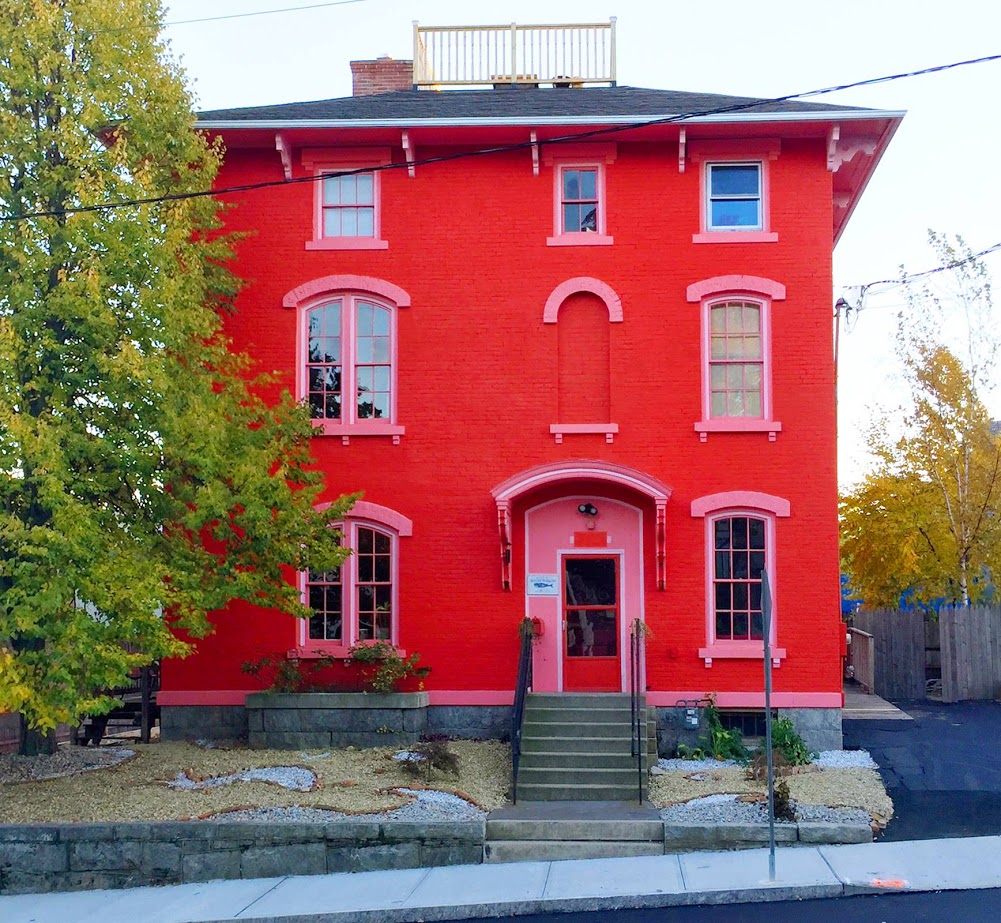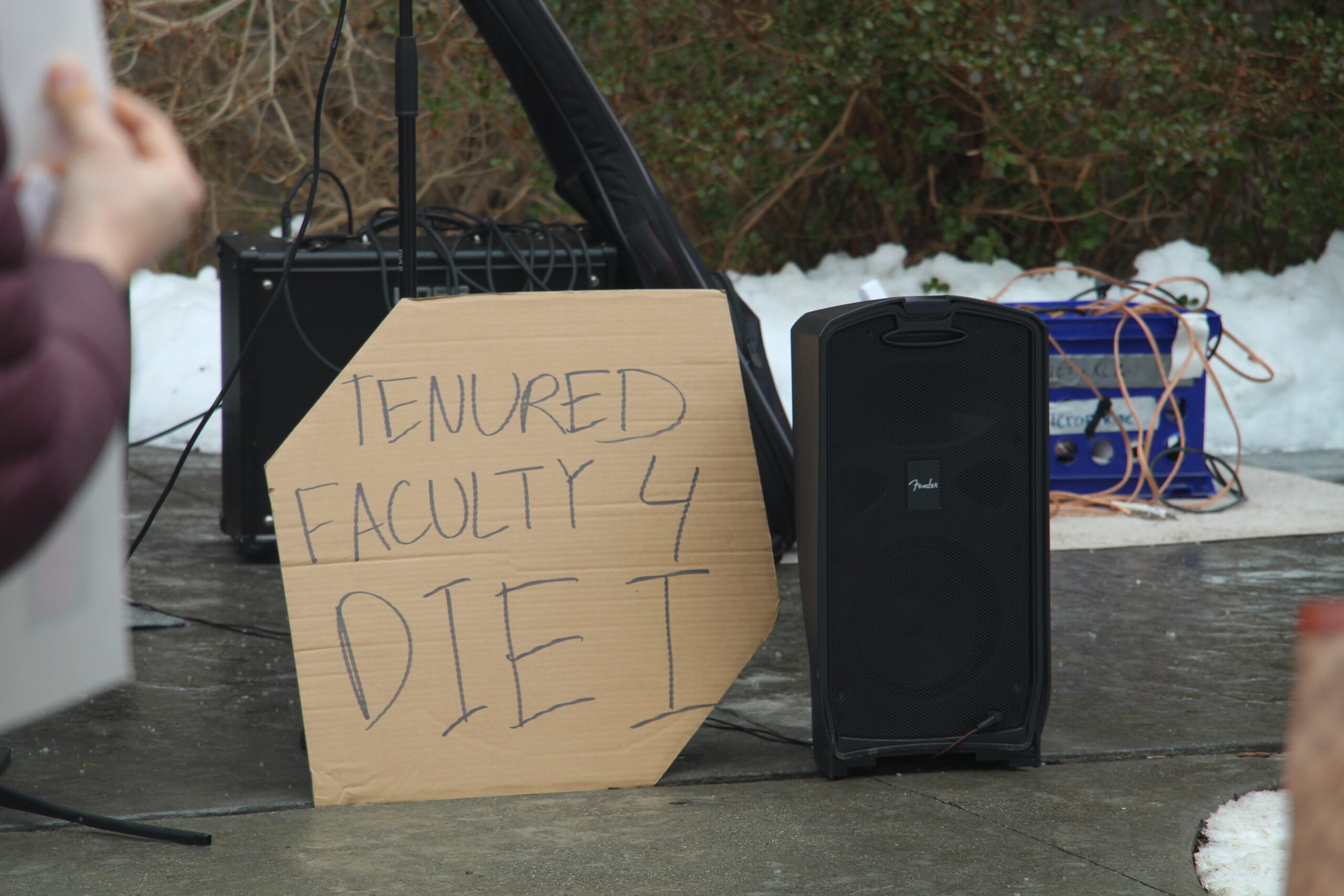Editor’s note: The following story was written for Professor Blanche Boyd’s class “Narrative Nonfiction” and was first published to Mike Alewitz’s Facebook page. An excerpted version of the story appeared in The College Voice April 3 print edition; this is the full version.
When I first contacted Mike Alewitz about an interview, I assumed we would be meeting alone. But as he offers me a seat at his dining room table, I realize we are in company. Seated across from me is a mannequin, her head tilted slightly to the left, as though she is listening but distracted. She has makeup on her eyelids and cheeks. Seated next to her is a large, plastic bunny with long white ears. To my left, a life-sized skeleton with a black top hat. His arm is outstretched across the wooden table. We are a full house. Above all of us hangs a painting with big letters that read: Capitalism Sucks.
Mike Alewitz is an activist, an artist and a former professor. He is 5’8 with a short buzz cut, fair skin and a few fine wrinkles that accentuate his cheekbones and chin. He sits leaning his elbows into the table. He has on tiny black spectacles, a black watch, a black turtleneck with loose black pants and one tiny black earring.
We are sitting in the dining room of Red Square, Mike Alewitz’s home, museum and gallery. Known by the community as the Red or Pink House, or even just the House on Federal Street, the building is identifiable by its fiery red exterior and vibrant pink detail. Just standing outside the front door, the paint so colorful, so rich, so unblemished, is enough to make anyone curious.
As we sit at the table, I ask Alewitz about himself. He does not tell me much about his early years. It is clearly not a time he is proud of, or that he cannot find the words to describe. Teenage years of rebellion, anger, or what, I will not know. When he finally makes eye contact with me he says, “If I had not become political, I probably would have died.”
Alewitz describes his career as being “ass-backwards.” While most artists turned political, he is an activist turned artist. At Kent State, where Alewitz went for some of his undergraduate years, he was the chairman of the Student Mobilization Committee and a witness to the Kent State Massacre. After the shooting, he left to become an organizer for anti-war movements, traveling to Austin, Los Angeles, Cleveland, New Orleans, Virginia, Boston, New Jersey. At the time he began working for the union movement, he was in industry as a railroad worker and machinist. He even laid some of the railroad tracks in New London, Connecticut that remain about half a mile from his house. While working, Alewitz picked up sign painting and billboard painting before going to the Massachusetts School of Art in his late thirties. He considers this the beginning of his art career. “I had the background,” he tells me. “I could render.”
Yet the start of Alewitz’s career was inextricable from the start of his censorship. At the Massachusetts School of Art, Alewitz had a weekly painted column and after dedicating a mural to a local Black man killed by the police, he walked in to find the police graffitiing all over it. Once the cops left, the president of the university had the mural and the graffiti painted over in white. Since then, Alewitz has been devoted to agitprop work, a combination of agitation and propaganda, which he also refers to as “high grade street art.”
As Alewitz speaks about his past, he becomes fidgety. Finally, as though to cure his own restlessness, he decides to give me a tour of his artwork and we both stand. Talking to Alewitz at the dining table is like trying to keep up with someone slipping back into their past. But talking to Alewitz while he shows me his art, it is as if I am suddenly in a classroom. I see him as a professor as he points to the figures in his work. He asks me, “Do you know who these people are?” and I stammer out a response, embarrassed of not knowing. He responds with engagement and challenge. He talks with expectations.
I find myself in his class as he takes me from mural to mural. He asks me if I recognize the people he painted for a border organization project in Mexico City. I shake my head no and he does not seem surprised. “We have been robbed of our history,” he says. The mural was done in commemoration for the Haymarket Massacre which took place in Chicago. The man and woman staring down at me are Albert and Lucy Parsons. Albert Parsons was one of the trade union workers who was framed and executed in the massacre.
In the next room is a mural of the history of New York. The mural includes the arrival of slaves on Wall Street, the killing of Native Americans, child labour, the Triangle Fire and Ota Benga, the black man who, in 1906, was put on display in the Bronx Zoo. All the imagery is saturated in purples, reds and orange. “We have been robbed of our history,” he says again.
We move back into the hallway and I notice a blue pair of mannequin legs by the front door. He takes me past a mural for striking mushroom workers in Kennett Square, Pennsylvania, the mushroom capital of the U.S. The church bells ring outside. He points to another mural, at the base of the stairs, done for the International Confederation of Energy and Mine Workers. Diagonal from it is a mural dedicated to Fall River Textile Workers. Another for the Rodney King rebellion in South Central L.A
“There is a book in every one of these stories,” he says. I realize then that I am only hearing pieces from his past. There are novels behind his paintings and behind those novels are history books. His house is a time capsule.
In 1999, the White House Millennium Council identified Mike Alewitz as a Millennium Artist. He was funded to design a series of murals called “Dreams of Harriet Tubman” that were supposed to be painted around Baltimore. The central mural shows Harriet Tubman holding a gun and on either side of her are red swirling waves. Silhouettes of people cluster and crowd at her feet. The mural was never made public. “You’re in a place where there are statues with white men with guns everywhere and they can’t…” his voice trails off as he tells me the story. “I painted the only image of a woman…a Black woman…with a gun.” After the mural was rejected, Alewitz issued an offer for a free mural but no one would provide a wall. “Everybody’s afraid,” he says. “It was censorship and not the kind that helps your career.”
Alewitz’s stories are a routine of acceptance and decline, of struggle and movement. His pieces are vibrant, loud, colorful. They declare to be acknowledged. Stored amongst the rooms of the house are boxes and boxes of press coverage from the censorship of his art. But, as Alewitz explains, not a single article has made it into an art journal. “The minute you start painting about this stuff, you cease to exist.” Alewitz leads me up his green, purple, and white stairs, and by the time we enter his studio, it is exactly what I expect. There are jars of paint brushes everywhere and canisters of paint. In the corner is a stack of what looks like bamboo. Hung up is a current project, a painting of C.L.R James, a Trinidadian socialist and historian, influenced by the colorful celebrations of carnival. In the adjacent room is a bookshelf dedicated to the complete collection of Karl Marx, Frederick Engels, and Lenin. Alewitz smiles when I stop to look at them. “Yeah,” he says, “I’m the real deal.”
Alewitz leads me up his green, purple, and white stairs, and by the time we enter his studio, it is exactly what I expect. There are jars of paint brushes everywhere and canisters of paint. In the corner is a stack of what looks like bamboo. Hung up is a current project, a painting of C.L.R James, a Trinidadian socialist and historian, influenced by the colorful celebrations of carnival. In the adjacent room is a bookshelf dedicated to the complete collection of Karl Marx, Frederick Engels, and Lenin. Alewitz smiles when I stop to look at them. “Yeah,” he says, “I’m the real deal.”
He then leads me back to the hallway. I point to the red carpets on the ground. They are splattered in paint. “That was my Pollock phase,” he laughs. He has a great laugh, a genuine, honest, chuckle that shows you despite everything, life can still be funny.

Dining room at Red Square
As we ascend the second staircase, we move from one country to another. A few steps up, and we are in Iraq. Photographs show a mural that he painted in Baghdad. It states, Artists and Workers Form One World Without Borders. In it is Layla Al-Attar, an Iraqi artist who was killed by a U.S missile attack, holding hands with an American worker. Above them are planes dropping bombs. The bombs turn into bread and roses as they pass the clasped hands. We move several more steps up. There is Rosa Luxemburg, Lenin, Malcolm X, and Alewitz’s friend, Mia Kuwada, all in one mural. A few more steps up and we are in Palestine. Pictures show several murals in which he painted walls with holes through them. He explains to me that this is an imagery often accredited to Banksy. “I did it first,” he says and then chuckles. “I want this for the record.”
When we reach the third floor, I ask Alewitz what it is like to see his work destroyed, a reccurring fate for his politically charged and public pieces. He describes that the success or failure in each piece is in its process and effect. Alewitz tells me the story of his first mural in the United States, the P-9 Mural for striking meat packers in Minnesota, where the national guard was called in. The mural was destroyed by the Hormel Company and workers were sent to jail. “A lot of the most famous strikes and struggles we think of in history actually didn’t win,” he explains. “But they won in the sense that they had a profound effect in what was going on. That is what my work is trying to do. That is how I judge it.”
If we take this measurement of success then perhaps we can call him one of the most successful artists. His artwork has taken him to Baghdad, Chernobyl, Mexico, Nicaragua, Northern Ireland, Israel and the Occupied Territories. It also brought him to Central Connecticut State University to teach the first mural painting and street art course. “I had hoped to teach. One of the reasons I went back to school,” he said. But until CCSU, his dream seemed unlikely. “Nobody would talk to me. I was a Marxist and everybody knew who I was.”
After sixteen years of working as a professor in the Art Department at CCSU, Alewitz retired this past January. Now that he is done teaching he says he will do “something somewhere,” maybe in New London. There is also talk about walking to California, some creative writing, and turning one of his rooms into a T-shirt shop.
Alewitz tells me we are now going to see the best part of the house, and I do not know what to expect. He leads me up a tiny staircase into the attic and then to a small ladder which leads to the roof. As he climbs up the ladder, the sunlight filling into the attic creates a spotlight around him. For a second, he looks like a painting, frozen between shadow and light, before he disappears. I follow him. This is where Alewitz spends his summers, on his small roof, with one of the best views of New London. In the distance you can see the Thames River and two churches. We don’t say much. We stand in silence, thinking different thoughts, taking it in. When we walk back down to the first floor of the house I comment on all the windows. None of them have any shades or blinds. The house is flooded with muted winter light. “I was poor most of my life,” he tells me. “I can’t bear to cover them.”
Before I leave, we stop in an office space. On the wall are several small paintings, and I note that they look different from his own. Alewitz explains to me that he found them at a yard sale and he slowly becomes more animated with his hands. A woman, a service worker at a school, was selling them and when he expressed interest she took him to a garage where she had hundreds more. He bought several for twenty bucks a piece. “Workers are taught that you are not supposed to be doing that. I am not good. I am not whatever…” he says and then he tells me about another guy he met who is doing a mosaic in his basement. He stops and thinks a while before speaking. “There are a bunch of these people around. If you keep your eyes open, you’ll find them.”











What an interesting, well documented and descriptive article. I had no idea this artist, Alewitz, exists. His work sounds profound. Wish I were a fly on the wall of his art studio!